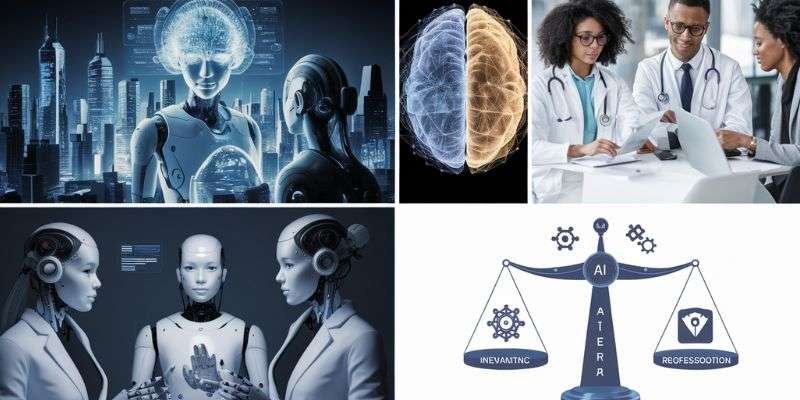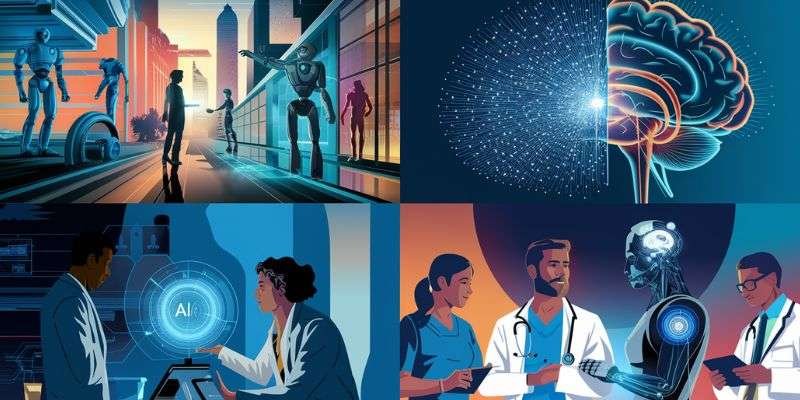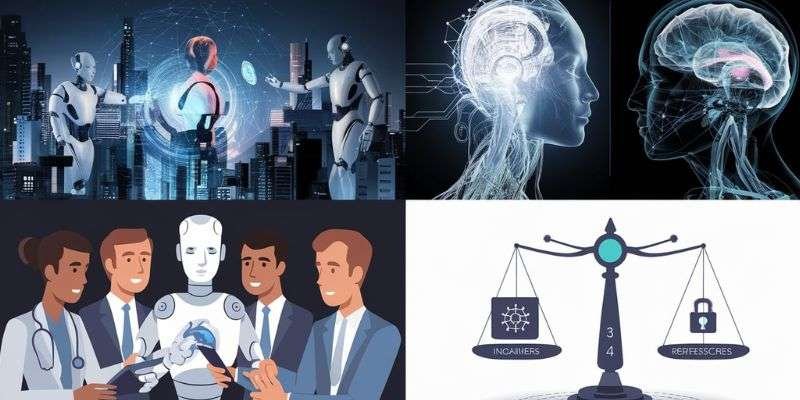
Artificial Intelligence (AI) has rapidly evolved from a concept of science fiction to a transformative force reshaping our world. As we stand on the brink of a new era, advanced AI systems are pushing the boundaries of what machines can achieve, promising to revolutionize industries, solve complex problems, and augment human capabilities in ways previously unimaginable. This article delves into the current state of advanced AI, exploring its implications, capabilities, limitations, and the ethical considerations that come with this powerful technology.
Advanced AI: Implications and Applications Across Industries

The emergence of advanced AI is ushering in a new era of innovation and efficiency across various sectors. From healthcare to finance, manufacturing to customer service, AI is reshaping how businesses operate and interact with their customers.
Transformative Impact on Business Operations
Advanced AI is revolutionizing business operations by streamlining processes, enhancing decision-making, and uncovering valuable insights from vast amounts of data. Machine learning algorithms and predictive analytics are enabling companies to optimize their strategies and stay ahead of market trends.
In the financial sector, AI-powered systems are transforming risk assessment and fraud detection. These intelligent algorithms can analyze millions of transactions in real-time, identifying suspicious patterns and potential threats with unprecedented accuracy. This not only protects businesses and consumers but also reduces the time and resources spent on manual audits.
Moreover, AI is revolutionizing supply chain management by predicting demand fluctuations, optimizing inventory levels, and identifying potential disruptions before they occur. This level of foresight allows businesses to operate more efficiently, reduce waste, and respond swiftly to changing market conditions.
Enhancements in Customer Experience and Engagement
Advanced AI is redefining customer interactions, enabling personalized experiences at scale. Natural Language Processing (NLP) and sentiment analysis are powering intelligent chatbots and virtual assistants that can understand and respond to customer queries with human-like empathy and efficiency.
These AI-driven systems are available 24/7, providing instant support and reducing wait times for customers. They can handle a wide range of inquiries, from simple FAQs to complex problem-solving, freeing up human agents to focus on more nuanced and high-value interactions.
Furthermore, AI is enhancing personalization in marketing and product recommendations. By analyzing user behavior, preferences, and historical data, AI algorithms can predict individual customer needs and deliver tailored content, offers, and experiences. This level of personalization not only improves customer satisfaction but also drives loyalty and increases conversion rates.
Revolutionizing Manufacturing and Supply Chain Management
In the manufacturing sector, advanced AI is driving the fourth industrial revolution, often referred to as Industry 4.0. AI-powered robots and cobots (collaborative robots) are working alongside humans, handling repetitive tasks with precision and consistency while adapting to new situations in real-time.
Predictive maintenance, powered by machine learning algorithms, is transforming how companies approach equipment upkeep. By analyzing sensor data and historical performance metrics, AI can predict when machinery is likely to fail, allowing for proactive maintenance that minimizes downtime and extends the lifespan of valuable assets.
In supply chain management, AI is optimizing logistics networks, predicting demand fluctuations, and enhancing inventory management. Advanced algorithms can analyze vast amounts of data from multiple sources, including weather patterns, economic indicators, and social media trends, to forecast demand with unprecedented accuracy. This enables companies to optimize their inventory levels, reduce waste, and improve overall supply chain efficiency.
Understanding Advanced Artificial Intelligence: Capabilities and Limitations

As we delve deeper into the world of advanced AI, it’s crucial to understand both its remarkable capabilities and its current limitations. This knowledge is essential for harnessing the full potential of AI while setting realistic expectations and addressing potential challenges.
Defining Advanced AI: Key Characteristics
Advanced AI refers to the cutting-edge systems and algorithms that exhibit high levels of intelligence, adaptability, and autonomy. These systems go beyond simple rule-based programming to demonstrate complex problem-solving abilities, learning capabilities, and sometimes even creativity.
One key characteristic of advanced AI is its ability to process and analyze vast amounts of data at incredible speeds. This enables these systems to uncover patterns and insights that would be impossible for humans to detect manually. Advanced AI systems often employ deep learning techniques, utilizing neural networks that mimic the human brain’s structure to process information and make decisions.
Another defining feature is the ability to adapt and improve over time. Through techniques like reinforcement learning, advanced AI systems can learn from their experiences and refine their performance without explicit programming. This self-improvement capability allows AI to tackle increasingly complex tasks and operate in dynamic environments.
Current Capabilities: What Can Advanced AI Do?
The capabilities of advanced AI are expanding rapidly, with breakthroughs occurring across various domains. In natural language processing, large language models like GPT-3 and its successors can generate human-like text, answer questions, and even engage in creative writing tasks with remarkable coherence and contextual understanding.
In computer vision, AI systems can now recognize and interpret visual information with superhuman accuracy. This has applications ranging from medical image analysis for early disease detection to autonomous vehicles that can navigate complex urban environments.
Advanced AI is also making significant strides in strategic decision-making. AI systems have defeated world champions in complex games like Go and poker, demonstrating an ability to make long-term plans and adapt to opponents’ strategies. In the business world, this translates to AI-powered systems that can analyze market trends, predict consumer behavior, and optimize complex supply chains.
Recognizing the Limitations of Advanced AI Systems
Despite their impressive capabilities, advanced AI systems still have significant limitations that are important to acknowledge. One major challenge is the “black box” problem, where the decision-making processes of complex AI models are often opaque and difficult to interpret. This lack of explainability can be problematic in critical applications where transparency and accountability are essential.
Another limitation is the dependence on large, high-quality datasets for training. AI systems can inadvertently perpetuate biases present in their training data, leading to unfair or discriminatory outcomes. Addressing this requires careful curation of training data and the development of techniques to detect and mitigate bias.
Advanced AI also struggles with generalization and transfer learning. While AI can excel at specific tasks it’s trained for, it often fails when faced with novel situations or tasks that require common sense reasoning. The ability to apply knowledge across different domains in the way humans do remains a significant challenge for AI researchers.
Lastly, the computational resources required for training and running advanced AI models are substantial. This raises concerns about the environmental impact of AI and the accessibility of this technology to smaller organizations or developing nations.
The Ethical Considerations of Advanced AI Development and Deployment

As advanced AI systems become more powerful and pervasive, they bring with them a host of ethical considerations that society must grapple with. From concerns about privacy and job displacement to questions of accountability and the potential for misuse, the development and deployment of AI technologies require careful consideration and robust ethical frameworks.
Balancing Innovation with Ethical Responsibility
The rapid pace of AI innovation presents both opportunities and challenges. While advanced AI has the potential to solve complex global problems and improve quality of life, it also raises concerns about unintended consequences and the potential for harm.
One key ethical consideration is the impact of AI on employment. As AI systems become more capable, there are concerns about job displacement across various sectors. While AI is likely to create new job categories, the transition may be challenging for many workers. Policymakers and business leaders must consider how to manage this transition, potentially through retraining programs and policies that support affected workers.
Another critical aspect is the responsible development of AI. This includes considering the long-term implications of AI systems and ensuring that they are designed with human values and well-being in mind. The concept of “AI alignment” – ensuring that AI systems’ goals and behaviors align with human values – is a crucial area of research and discussion in the AI ethics community.
Addressing Bias and Fairness in AI Algorithms
One of the most pressing ethical challenges in AI development is addressing bias and ensuring fairness. AI systems can inadvertently perpetuate or even amplify societal biases present in their training data, leading to discriminatory outcomes in areas such as hiring, lending, and criminal justice.
Researchers and developers are working on techniques to detect and mitigate bias in AI systems. This includes developing more diverse and representative training datasets, implementing fairness constraints in AI algorithms, and creating tools to audit AI systems for bias.
However, defining fairness in AI is not straightforward, as different notions of fairness can sometimes be in conflict with each other. This highlights the need for ongoing dialogue between AI developers, ethicists, policymakers, and affected communities to establish guidelines and best practices for fair AI systems.
Privacy Concerns and Data Security Issues
The development of advanced AI relies heavily on large datasets, often including personal information. This raises significant privacy concerns, particularly as AI systems become more integrated into our daily lives.
There’s a growing need for robust data protection regulations and practices to ensure that personal information is collected, used, and stored responsibly. This includes implementing strong encryption, anonymization techniques, and giving individuals greater control over their data.
The concept of “privacy-preserving AI” is gaining traction, with techniques like federated learning allowing AI models to be trained on distributed datasets without centralizing sensitive information. However, balancing the need for data to improve AI systems with individual privacy rights remains an ongoing challenge.
The Path Forward: Addressing Challenges and Fostering Responsible Advanced AI Development
As we navigate the complex landscape of advanced AI, it’s crucial to address the challenges head-on while fostering an environment that promotes responsible development and deployment. This requires a multifaceted approach involving collaboration between researchers, industry leaders, policymakers, and the public.
Promoting Transparency and Explainability in AI Systems
One of the key challenges in advanced AI is the “black box” nature of many complex models. Improving the transparency and explainability of AI systems is crucial for building trust and enabling meaningful human oversight.
Researchers are developing techniques for “explainable AI” (XAI) that aim to make the decision-making processes of AI systems more interpretable. This includes methods for visualizing neural network activations, generating natural language explanations for AI decisions, and developing more inherently interpretable AI architectures.
Promoting transparency also involves open communication about the capabilities and limitations of AI systems. Companies deploying AI should be clear about when and how AI is being used, especially in high-stakes applications like healthcare or financial services.
Investing in AI Safety and Robustness
As AI systems become more powerful and autonomous, ensuring their safety and robustness becomes paramount. This includes developing AI systems that are resilient to adversarial attacks, can handle unexpected situations gracefully, and have reliable fail-safe mechanisms.
Research in AI safety is exploring concepts like “corrigibility” – the ability to interrupt and correct an AI system if it starts to behave in unintended ways. Other areas of focus include developing AI systems with built-in ethical constraints and creating testing environments that can rigorously evaluate the safety of AI before deployment.
Fostering Interdisciplinary Collaboration and Ethical AI Education
Addressing the complex challenges of advanced AI requires collaboration across disciplines. Computer scientists need to work alongside ethicists, sociologists, psychologists, and policymakers to ensure that AI development takes into account diverse perspectives and societal implications.
Moreover, there’s a growing need for ethical AI education. This includes integrating ethics courses into computer science curricula, providing ongoing ethical training for AI practitioners, and raising public awareness about the implications of AI technologies.
Developing Adaptive Regulatory Frameworks
The rapid pace of AI advancement poses challenges for traditional regulatory approaches. There’s a need for adaptive regulatory frameworks that can keep pace with technological developments while providing adequate safeguards.
This might involve creating AI-specific regulations, updating existing laws to account for AI technologies, and establishing international cooperation to address the global nature of AI development. Regulatory sandboxes, where new AI technologies can be tested in controlled environments, could provide valuable insights for policymakers.
Empowering Human-AI Collaboration
While much attention is focused on the autonomy of AI systems, the path forward likely involves developing advanced AI that augments and empowers human capabilities rather than replacing them entirely.
Research into human-AI collaboration is exploring how to design AI systems that complement human strengths, facilitate more natural human-AI interactions, and create interfaces that allow non-experts to leverage AI capabilities effectively.
Conclusion
The dawn of advanced AI marks a transformative era in human history, offering unprecedented opportunities to solve complex problems, enhance human capabilities, and drive innovation across industries. However, this powerful technology also brings significant challenges and ethical considerations that we must address proactively.
As we move forward, it’s crucial to foster a balanced approach that harnesses the potential of advanced AI while prioritizing ethical considerations, transparency, and human values. This requires ongoing collaboration between researchers, industry leaders, policymakers, and the public to shape the development and deployment of AI in ways that benefit society as a whole.
Leave a Reply